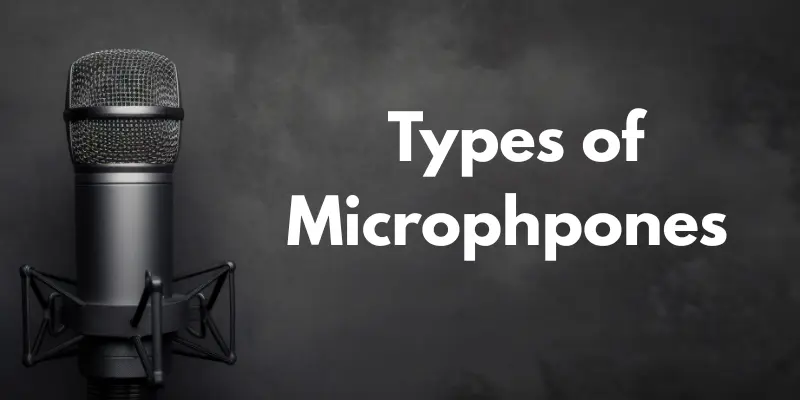Top 10 Types of Microphones: Which One Is Right for You?
Published: July 31, 2025
Tired of using the wrong microphone and receiving terrible sound quality? Many people are unaware that using the wrong microphone might harm their audio. Understanding the various types of microphones is the first step toward producing better, more professional audio, whether you’re recording music, podcasts, or films.
How Microphones Work
Microphones work by converting sound into an electric signal. It all starts with sound waves, which are the vibrations produced when you speak, sing, or play an instrument.
Every microphone contains a small component known as a diaphragm. When sound waves strike the diaphragm, it vibrates. These vibrations are then converted into an electrical signal by various internal components, depending on the microphone type.
Here’s the simple process:
- You make a sound (talk, sing, play music).
- Sound waves travel through the air and reach the microphone.
- The diaphragm inside the mic vibrates with the sound.
- The microphone converts these vibrations into an electrical signal.
- That signal is sent to your recording device, speaker, or computer.
This is how your voice or any sound becomes something that can be recorded, edited, or amplified.

10 Most Common Types of Microphones
Microphones come in various types, each designed for specific uses and sound qualities. Knowing the different types of microphones can help you choose the right one for your recording or live sound needs.
1. Dynamic Microphone
Dynamic microphones are both durable and versatile. They convert sound into an electrical signal using a coil and a magnet. These microphones handle loud sounds well and are ideal for live performances, vocals, and instruments. They don’t require external power and are usually more affordable.
2. Condenser Microphone
Condenser microphones are highly sensitive and accurate. They record detailed audio, making them ideal for studio recordings, performers, and acoustic instruments. These microphones require external power (often phantom power) to function. They are good for quiet settings but not for noisy or harsh environments.
3. Ribbon Microphone
Ribbon microphones provide a warm, natural sound. They use a thin metal ribbon to capture sound vibrations. These microphones are ideal for vocals, string instruments, and vintage-style recordings. They are very sensitive and should be handled with care. Not suitable for loud sounds or outdoor use.
4. Lavalier Microphone
Lavalier microphones are small and clip to clothing. They are ideal for interviews, presentations, and video recordings that require hands-free use. These microphones are typically wired or wireless and capture clear speech. Ideal for mobile or hidden mic setups.
5. Shotgun Microphone
Shotgun microphones are long and narrow, designed to pick up sound from a specific direction. They tune out background noise and concentrate on what’s directly in front of them. These microphones are suitable for film, television, interviews, and outdoor recordings. Frequently mounted on cameras or boom poles.
6. USB Microphone
USB microphones are plug-and-play devices that connect directly to a computer or laptop. They are great for podcasting, streaming, voiceovers, and video calls. These mics don’t need extra audio equipment and are perfect for beginners or home studios.
7. Stereo Microphone
Stereo microphones capture sound from two directions, resulting in a wide, realistic audio image. They’re ideal for recording live music, natural sounds, and outside environments. These microphones create a natural sense of space and depth, making the audio more immersive.
8. Wireless Microphone
Wireless microphones transmit sound without the need for cables, allowing you to move easily. They’re ideal for live performances, presentations, and events where mobility is critical. These microphones use radio signals or Bluetooth and require batteries to function.
9. Contact Microphone
Contact microphones detect vibrations directly from surfaces rather than air. They are used to capture sound from instruments such as guitars and violins, as well as objects where traditional microphones would not work well. Ideal for unusual sound recordings and experimental music.
10. Boundary Microphone
Boundary microphones, also known as PZM mics, pick up sound reflections from flat surfaces such as walls or tables. They capture clear audio in conference rooms, theaters, and stage performances. Ideal for recording group conversations or ambient sounds.
How to Choose the Right Microphone
Choosing the right microphone depends on your needs and setup. Consider these key factors:
- Purpose: Are you recording vocals, instruments, podcasts, or videos? Different mics suit different uses.
- Environments: Will you record inside, outside, or in noisy environments? Some microphones are more effective at handling background noise.
- Connection Type: Do you want USB for easy computer use or XLR for professional gear?
- Directionality: Choose based on how much sound you want to pick up—some mics focus on a single source, while others capture a larger area.
- Budget: Microphones come in a range of prices. Pick one that fits your budget but still meets your quality needs
- Portability: Do you need a microphone for mobile or studio use? Wireless or compact microphones may be more suitable for mobility.
Understanding Polar Patterns
Polar patterns describe the directions from which a microphone picks up sound. Different patterns help capture sound in various ways:
- Cardioid: Picks up sound mostly from the front, reducing background noise. Great for vocals and solo instruments.
- Omnidirectional: Captures sound equally from all directions. Ideal for group recordings or ambient sounds.
- Bidirectional (Figure 8): Picks up sound from the front and back but rejects sides. Useful for interviews or duets.
- Shotgun: Highly directional, focusing on sound from far away while blocking side noise. Perfect for film and outdoor use.
Understanding these patterns helps you choose the right microphone for your recording environment.
Conclusion
Choosing the right microphone can greatly enhance your audio quality and overall experience. Now that you’ve learned about the various types of microphones, take some time to explore them further and consider what best suits your needs. Whether you’re recording music, podcasting, or filming, the ideal microphone is out there for you. Don’t be afraid to experiment with different options until you find one that truly brings your sound to life!
Frequently Asked Questions [ FAQs ]
Here are some frequently asked questions to help you understand the topic better.
The four main types of microphones are:
- Dynamic Microphone
- Condenser Microphone
- Ribbon Microphone
- Lavalier Microphone
USB microphones are simple to use with computers, but they may not produce the same sound quality as professional XLR microphones. For serious music, an XLR condenser microphone is usually preferred.
Yes, ribbon mics are delicate because they use a thin metal ribbon inside. Handle them carefully and avoid loud sounds or rough use.
The two main types of stand microphones are:
- Straight Mic Stand: This is the most basic and traditional type of microphone stand.
- Boom Stand: Boom mic stands have an extendable arm that allows for greater flexibility in microphone positioning.

- Be Respectful
- Stay Relevant
- Stay Positive
- True Feedback
- Encourage Discussion
- Avoid Spamming
- No Fake News
- Don't Copy-Paste
- No Personal Attacks

- Be Respectful
- Stay Relevant
- Stay Positive
- True Feedback
- Encourage Discussion
- Avoid Spamming
- No Fake News
- Don't Copy-Paste
- No Personal Attacks





